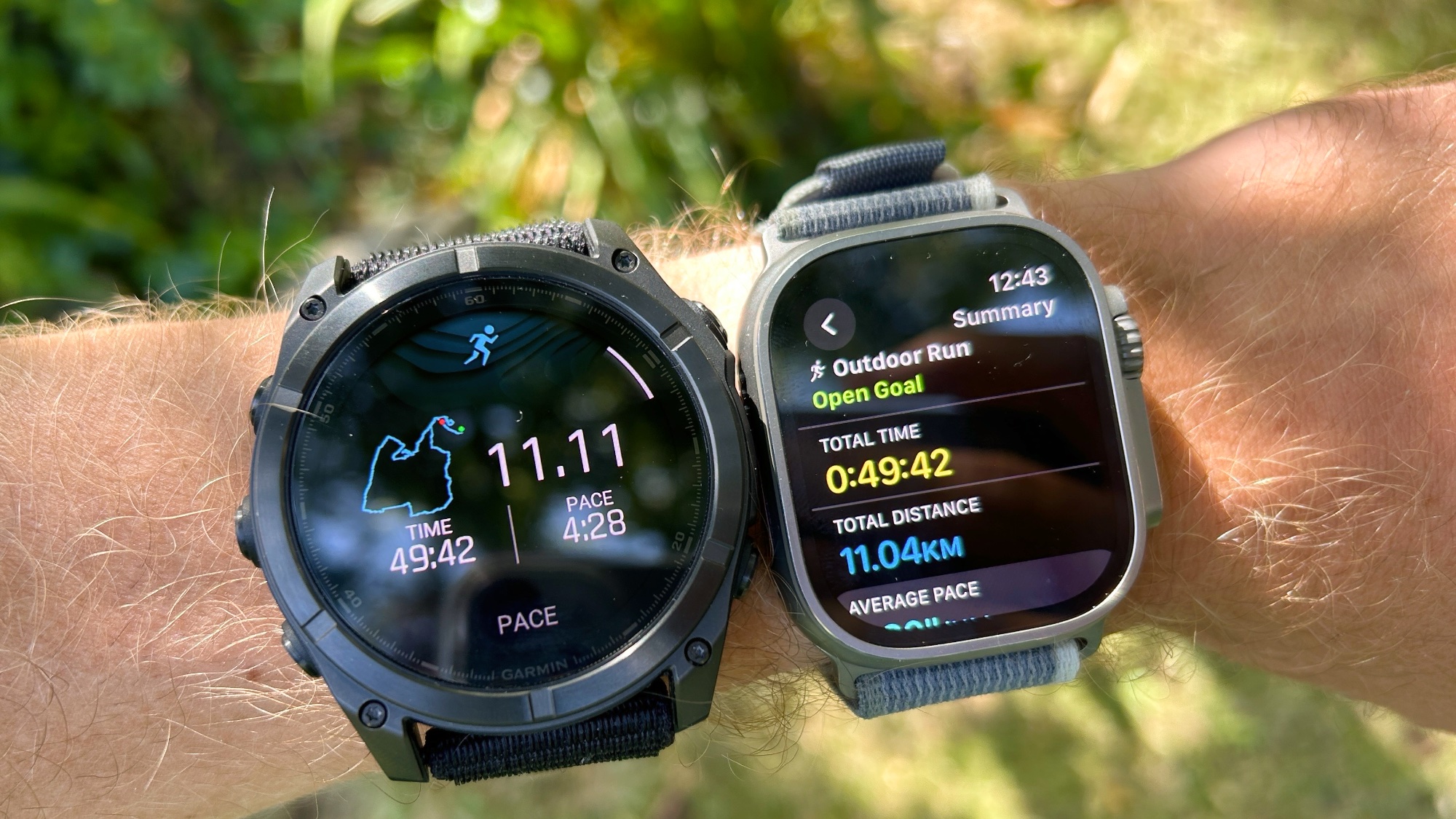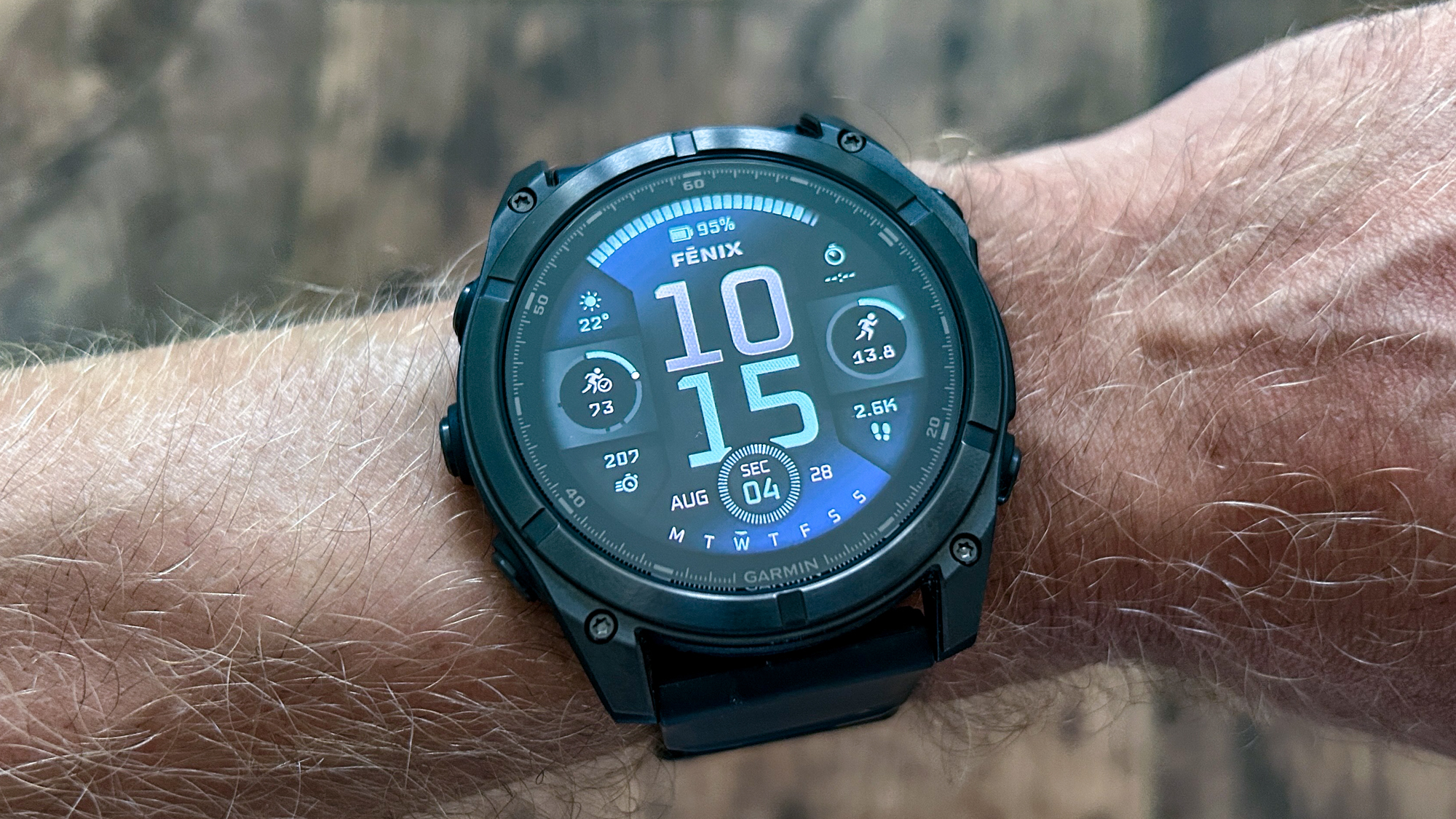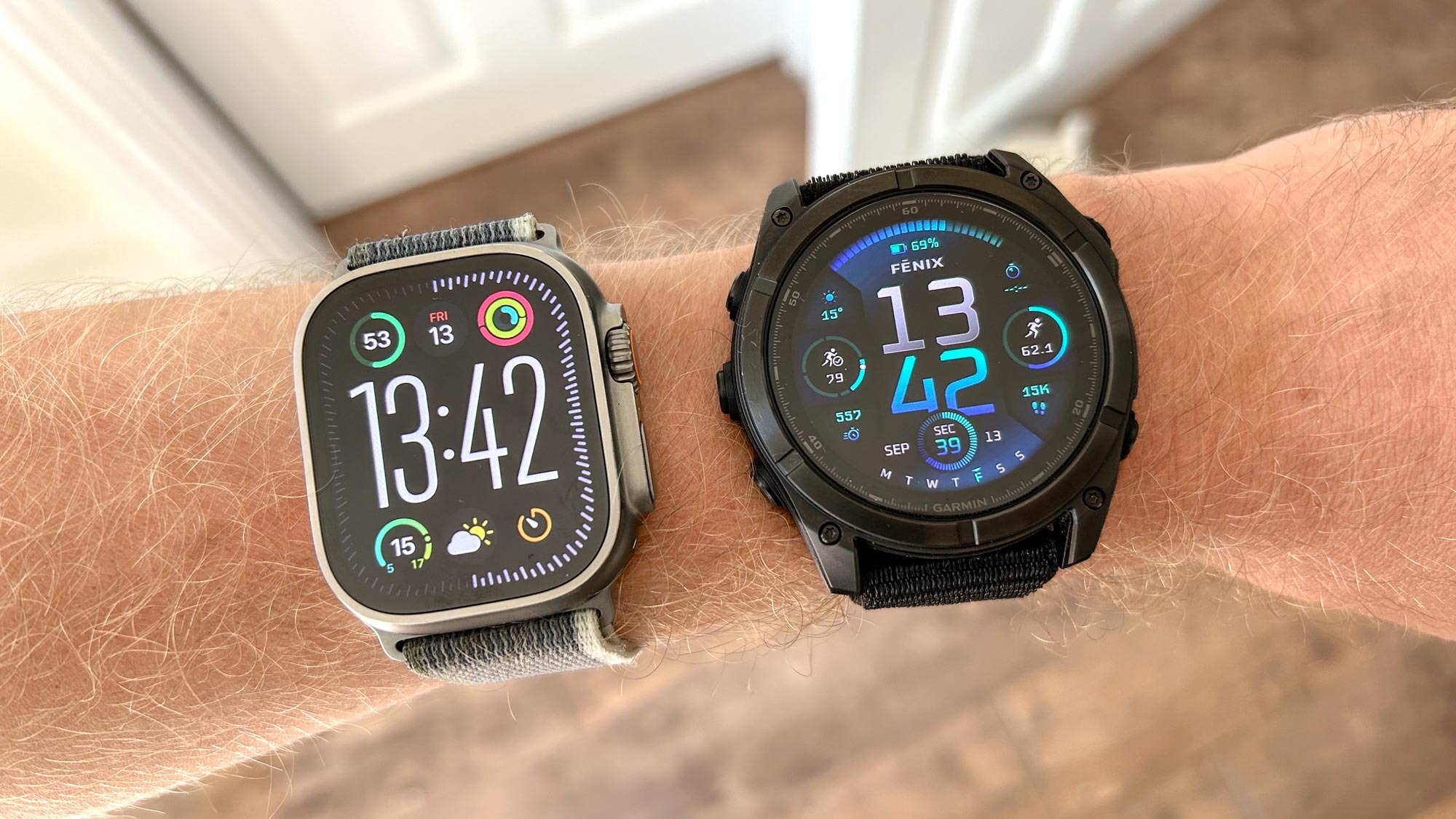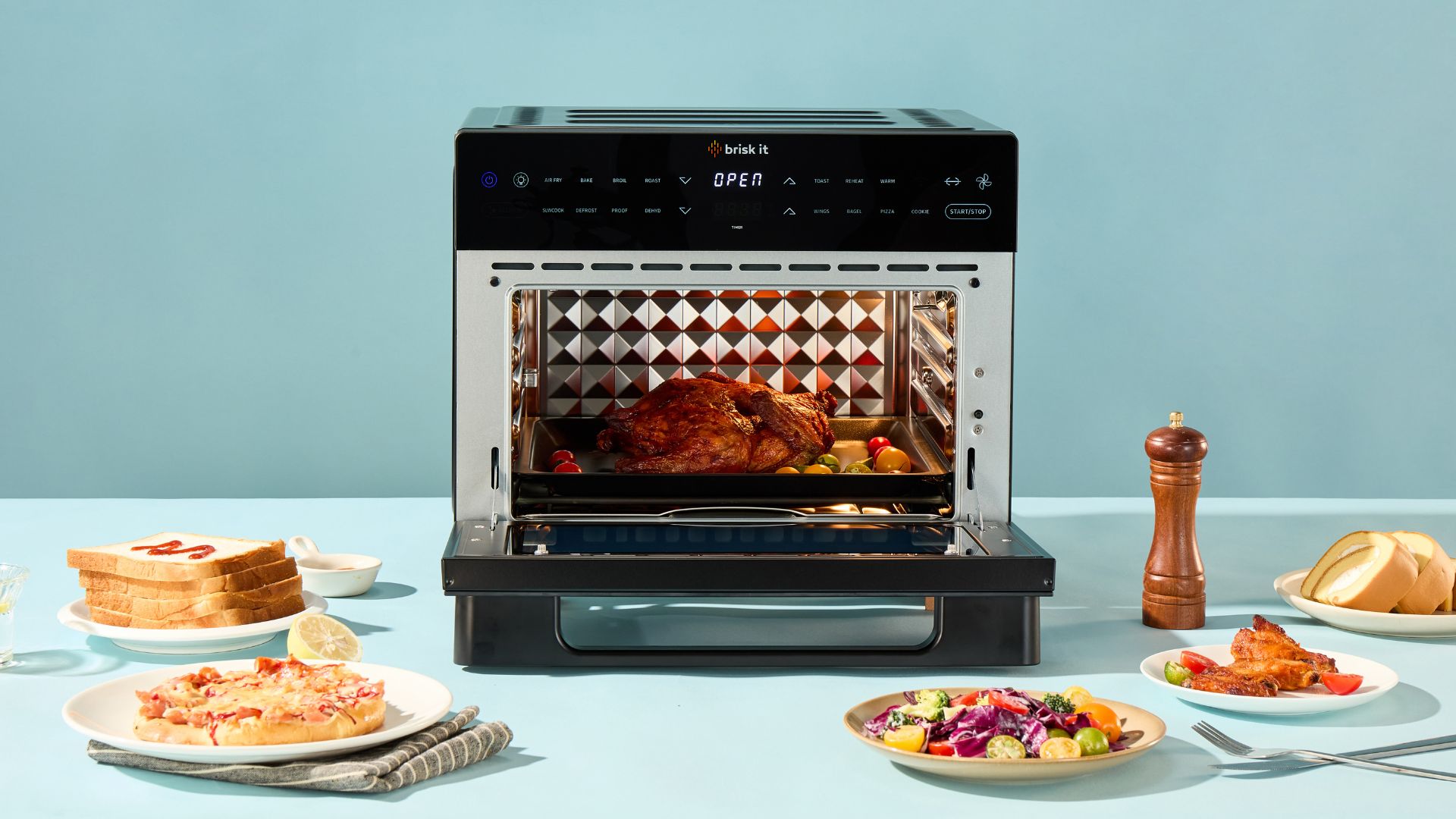Apple Watch Ultra 2 vs Garmin Fenix 8: Which smartwatch should you buy?
Which sporty smartwatch should you get?

Our Garmin Fenix 8 vs Apple Watch Ultra 2 comparison will help you if you're looking for a great outdoors smartwatch. These are two of the best smartwatches you can get, with both offering a winning combination of great design, useful smart features and insightful sports tracking and training analysis.
The Apple Watch Ultra 2 is the sportiest model in Apple’s range, with a more rugged design than the Apple Watch 10, plus longer battery life, an extra button and more accurate GPS tracking. The Fenix 8 is the best Garmin watch available and contains all of the stellar sports and adventure features you expect from the brand, and it comes with either an AMOLED display or solar tracking.
In this comparison I’ll focus on how the AMOLED version of the Fenix 8 shapes up against the Apple Watch Ultra 2. I’ve tested both watches extensively and while both are excellent options, they have different strengths and weaknesses. Before diving into the details, it’s worth noting that the Apple Watch Ultra 2 only works with iOS devices, so if you’re an Android user, the Fenix 8 is the better pick thanks to its cross-platform compatibility.
If you’d prefer to dive into either watch in more detail, check out our Garmin Fenix 8 review or our Apple Watch Ultra 2 review, and if you’re looking for a cheaper model from either brand the Apple Watch 10 and the Garmin Forerunner 965 are both excellent options.
Apple Watch Ultra 2 vs Garmin Fenix 8: Price and availability
The Garmin Fenix 8 launched in August 2024 and costs from $999 to $1199, depending on the model and size you pick. The Apple Watch Ultra 2 launched in September 2023 and costs $799.
There are two models of the Fenix 8, one with an AMOLED screen and one with a memory-in-pixel display and solar charging, and three sizes — 43mm, 47mm and 51mm. The AMOLED watch comes in all three sizes, whereas the solar watch is only available in 47mm and 51mm.
With the AMOLED Fenix 8 you choose between a steel bezel and back with a glass screen, or a titanium bezel and back with a sapphire crystal screen, with the latter being $100 more expensive. The solar Fenix 8 only comes in titanium with a sapphire screen.
Get instant access to breaking news, the hottest reviews, great deals and helpful tips.
Things are simpler with the Apple Watch Ultra 2, which is now available in two colors — black and natural titanium — but in only one size, with the 49mm watch having a titanium case and a sapphire crystal display.
Apple Watch Ultra 2 vs Garmin Fenix 8: Design and display

I tested the 51mm version of the Garmin Fenix 8, which is a large watch and feels it on my thin wrists. The same is true of the Apple Watch Ultra 2, but with both you get used to the size quickly and I found both watches comfortable to wear 24/7.
Whether you prefer the round design of the Fenix 8 or the rectangular Apple Watch Ultra 2 is a matter of personal preference and I go back and forth on it myself. Both are elegant designs and while the Fenix 8 leans more sporty, it’s a good-looking watch you can wear anywhere.
The Fenix 8 has Garmin’s usual five-button setup and a touchscreen, if you prefer to use that to navigate its menus. The Apple Watch Ultra 2 has three buttons, one of which is a dial. In practice I found the controls on both watches easy to use inside and outside of workouts, with no lag on the touchscreens with either.
Both watches have impressive displays, but the Retina OLED screen on the Ultra 2 shines a little brighter, partly because Apple makes better use of the vivid display with its watch face options and menus. The Garmin Fenix 8 AMOLED screen is fantastic though, and Garmin has improved the user interface on the watch to bring more color options to the watch faces and make the widgets more engaging.
One big design advantage the Fenix 8 has is a built-in flashlight on the top of the watch, which has four brightness settings and a red light mode. The Apple Watch Ultra 2 can use its screen as a flashlight, but its not as bright or as useful as the on on the Fenix.
In terms of sensors, both of these watches offer dual-band GPS tracking and have optical heart rate sensors capable of taking an ECG (this feature is limited to the US with the Fenix 8). Both also measure your overnight skin temperature and heart rate variability and the Fenix 8 can measure your blood oxygen saturation — this last feature is not available on newly-sold Apple Watch Ultra 2s in the US at the moment owing to the ongoing dispute with Masimo.
Both are rugged watches built to withstand adventurous activities and both are capable of being used for diving. The Garmin Fenix 8 has leakproof buttons, a 10ATM waterproof rating and can be used for diving to depths of 40m. The Apple Watch Ultra 2 also has a WR100 rating and can be used for diving to depths of 40m.
In terms of the desig, both are great-looking and durable watches, so which comes out on top will mostly depend on your preference for the round vs rectangular shape, though the range of sizes the Fenix 8 comes in means that it will be better for smaller wrists if you opt for the 43mm option.
Apple Watch Ultra 2 vs Garmin Fenix 8: Battery life

Battery life is an area where you expect Garmin watches to have the edge and that’s certainly the case with the Fenix 8 vs the Apple Watch Ultra 2. Whatever size Fenix 8 you opt for, you’ll enjoy several days of use, and the Fenix 8 51mm lasted me 12-13 days with the screen always-on and running every day.
The Apple Watch Ultra 2 has lasted me two days reliably throughout my testing, which is actually longer than the 36-hour estimate given by Apple. Even when I ran a marathon with the Apple Watch Ultra 2 it still hit the 36-hour mark.
During activities the Apple Watch Ultra 2 uses the multi-band GPS setting by default and offers up to 12 hours of tracking. This can be extended to 35 hours if you use the low power mode on the watch so it takes fewer heart rate and GPS readings.
The Garmin Fenix 8 has several different GPS options you can pick between, with the one I used most often being the AutoSelect mode that picks the best GPS mode for you to balance battery life and accuracy. This offers up to 49 hours of battery life with the 51mm watch with the screen always-on, which drops to 16 hours for the smallest 43mm watch.
While the two-day battery life on the Apple Watch Ultra 2 means it’s not hard to get into a rhythm of charging the watch, the Garmin Fenix 8’s longer battery is much more convenient and it meant I could go on weekend or even week-long trips without taking a charger. If you opt for the solar version of the Fenix 8, then the battery life will be even more impressive.
Apple Watch Ultra 2 vs Garmin Fenix 8: Sports tracking and training analysis

The Apple Watch Ultra 2 and Garmin Fenix 8 are both formidable sports watches with a multitude of sports modes including a multisport option with automatic transitions and a dedicated track running feature for extra accuracy when you’re running in 400m circles.
Both allow you to create and follow structured workouts and customize your data fields, and you can even follow full training plans on either watch — with Garmin these are native while on Apple you link services like TrainingPeaks to the Workout app, or use third-party apps like Runna.
I found both to offer impressive GPS accuracy, with the multi-band GPS option allowing for consistent pace and distance stats even in tricky GPS environments like city centers. I ran the London Marathon with the Apple Watch Ultra 2 and the pace stats were even throughout and the overall distance recorded of 26.2-miles can’t be faulted.

Both watches are also pretty reliable for heart rate tracking. In general, I find optical heart rate monitors to be hit and miss for me, especially during runs, and both watches are less accurate than a chest strap like the Wahoo TRACKR, especially during interval workouts.
You can use both without an external sensor and get good results, but the heart rate data is used to power the training analysis on both watches, so you want the most accurate data going in as possible.
Apple added a new training load feature to its watches this year which I have tested through the Public Beta for watchOS 11, which allows you to rate the intensity of your workouts. This rating is used to compare your recent 7-day training load with your 28-day load so you can see if you’re working at the right level to improve without pushing too hard.
It’s a useful feature and I like the amount of control you have over the data, since you rate your effort level yourself (the watch estimates it for many activities, but you can adjust it). In contrast you can’t adjust the training load for individual workouts on Garmin watches, but it’s fair to say you get a lot more analysis from the Fenix 8.
Along with training load, which is broken down into more detail like aerobic vs anaerobic focus, the Fenix 8 gives you stats like your hill score and endurance score, plus race estimates and suggested workouts to help you balance your training load. The Fenix 8 also has a Training Readiness rating based on factors like your recent sleep and activity, which you can use to judge how hard to push that day.
There is a lot more depth to the training analysis on the Fenix 8, but the Apple Watch Ultra 2 does offer a smart approach to training load, and the sports tracking is impressive on both. One benefit to the Apple Watch Ultra 2 is that if you don’t like the native Workout app, you can use one of the best Apple watch apps instead — WorkOutDoors is one I use a lot that allows more customization and has maps.
Apple Watch Ultra 2 vs Garmin Fenix 8: Smartwatch features

The Fenix 8 has all of Garmin’s top smart features, including NFC payments, music storage with the ability to connect with Spotify, Deezer and Amazon Music accounts, and access to the Connect IQ app store. It also has a mic and speaker so you can take calls on the Fenix 8, and also give it voice commands.
However, this is an area where the Apple Watch Ultra 2 is clearly ahead, with access to the App Store and cellular connectivity being key features on the watch. While the Connect IQ app store does have some handy apps and a lot of watch faces, the App Store is on another level and any frustrations you might have with the features on the Apple Watch can often be remedied by finding a third-party app. Apple’s Wallet app is also regularly very useful to me, storing train and plane tickets, as well as store loyalty cards.
If smarts are your main priority then the Apple Watch Ultra 2 is the clear pick here, especially if you want to stay connected while leaving your phone behind during activities, but the Fenix 8 doesn't have some key smartwatch features that might be all you need.
Apple Watch Ultra 2 vs Garmin Fenix 8: Maps and navigation
Apple has been improving the maps and navigation features on the Apple Watch Ultra 2 over the last two years, and you can now create custom routes with turn-by-turn navigation using the offline maps on the watch. One problem with this is that you still have to use separate apps for maps and workouts, so you have to switch between them while navigating a route during a run, for example.
Garmin’s routing features are best-in-class for sports watches and you can see maps and routes within the data fields of your workout. The Fenix 8 can also create routes for you on the fly, and guide you home if you get lost during an activity. The Fenix 8 also has Garmin’s ClimbPro feature, which shows you the climbs and descents on a route individually to help you judge your effort during them, something I find very useful on long uphills in particular.
While the Apple Watch’s native navigation features can’t match Garmin’s, the gap is closed by using third-party apps like WorkOutDoors or Footpath, which you can use to see routes and elevation information during workouts.
Apple Watch Ultra 2 vs Garmin Fenix 8: Verdict
As a keen, nigh-on obsessive, runner I would be happy using either the Apple Watch Ultra 2 or Garmin Fenix 8 as my main training watch. The Garmin Fenix 8 does have some major advantages for sports though, with more extensive training analysis, incredible navigation tools and far longer battery life.
The Apple Watch Ultra 2 does offer more smartwatch features, and it’s a more engaging watch to use during the day with excellent health and activity tracking. Its sports tracking might be more simple than Garmins, but it’s accurate and I like the user-led approach to training load myself, and the App Store can usually deliver an option for any features you are missing.
While there’s a lot of overlap between the two, I’d sum it up by saying the Apple Watch Ultra 2 is the sportiest smartwatch I’ve tested, while the Garmin Fenix 8 is the smartest sports watch. If sports are your focus then the Fenix 8 is the way to go, while Apple has the edge on smarts.

Nick Harris-Fry is an experienced health and fitness journalist, writing professionally since 2012. He spent nine years working on the Coach magazine and website before moving to the fitness team at Tom’s Guide in 2024. Nick is a keen runner and also the founder of YouTube channel The Run Testers, which specialises in reviewing running shoes, watches, headphones and other gear.
Nick ran his first marathon in 2016 and became obsessed with the sport. He now has PBs of 2hr 25min for the marathon and 15min 30sec for 5K. Nick is also a qualified Run Leader in the UK.
Nick is an established expert in the fitness area and along with writing for many publications, including Live Science, Expert Reviews, Wareable, Coach and Get Sweat Go, he has been quoted on The Guardian and The Independent.
